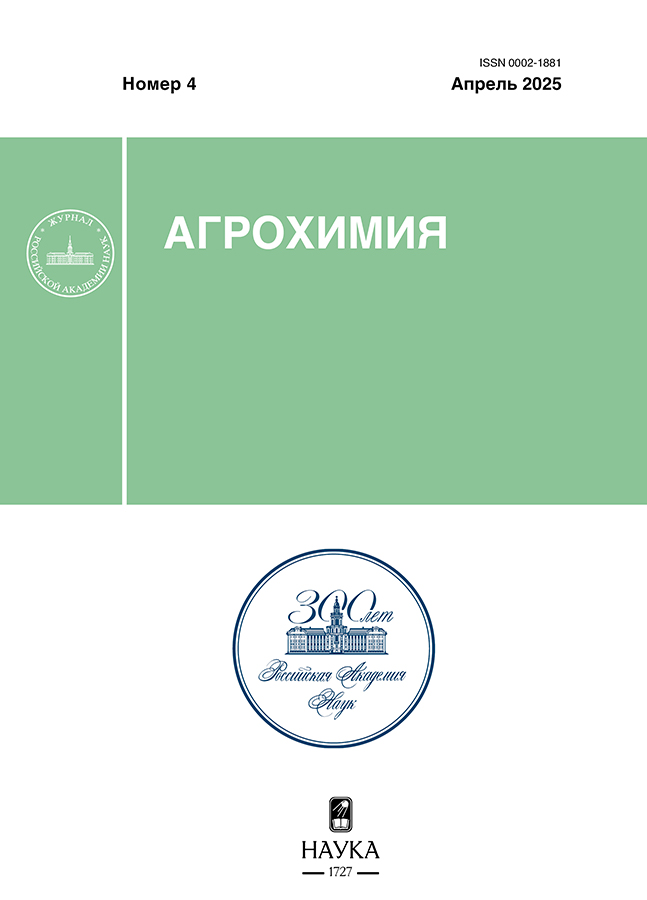Influence of a New Biostimulant on the Germination and Germination Energy of Rice, Spring Barley and Winter Wheat Seeds
- Authors: Kartabaeva B.B.1, Ulyanenko L.N.1, Mikhalyova S.N.1, Budynkov N.I.1, Derbeneva D.S.1, Amosova N.V.2, Demin D.V.1
-
Affiliations:
- All-Russian Research Institute of Phytopathology
- Obninsk Institute of Atomic Energy — a branch of the MEPhI National Research Nuclear University
- Issue: No 4 (2025)
- Pages: 57-62
- Section: Experimental Articles
- URL: https://edgccjournal.org/0002-1881/article/view/682976
- DOI: https://doi.org/10.31857/S0002188125040078
- EDN: https://elibrary.ru/UNWJPN
- ID: 682976
Cite item
Abstract
The effect of treating rice seeds (Oryza sativa japonica) of the Koshihikari variety, spring barley (Hordeum vulgare L.) of the Moskovsky 86 variety and winter wheat (Triticum aestivum L.) of the Nemchinovskaya 85 variety with a new biostimulator (BS) on the germination and development of seedlings was studied. The biostimulator was obtained at the All-Russian Research Institute of Phytopathology using the developed technology of liquid-phase catalytic oxidation of starch-containing raw materials. The biostimulator (concentrate with a molecular weight ≥ 30 kDa) contains a complex of phytohormones of cytokinic and gibberellic nature, free amino acids, and hydroxycinnamic acids. Soaking rice seeds in BS solution at concentrations of 10–4, 10–5, and 10–6 ml/l stimulated their germination and increased root length by 2.6–2.7 times. A more intensive accumulation of seedling biomass (43% more than in the control) was observed when using BS at a concentration of 10–6 ml/l. After treating the surface of spring barley seeds with a biostimulator at a concentration of 10–6 ml/l, an increase in germination energy, laboratory germination, length of the main germinal root, and the wet mass of roots and seedlings were noted. The trends towards changes in the morphophysiological parameters of the development of winter wheat seedlings largely coincided with the results for barley. The highest rates were observed when using BS at a concentration of 10–6 ml/l. The data obtained indicated the positive effect of the new biostimulator on the germination of seeds of various grain crops.
Full Text
About the authors
B. B. Kartabaeva
All-Russian Research Institute of Phytopathology
Author for correspondence.
Email: kartabaeva040893@mail.ru
Russian Federation, 5, Institute St., Bolshie Vyazemy, Odintsovsky District, Moscow Region, 143050
L. N. Ulyanenko
All-Russian Research Institute of Phytopathology
Email: kartabaeva040893@mail.ru
Russian Federation, 5, Institute St., Bolshie Vyazemy, Odintsovsky District, Moscow Region, 143050
S. N. Mikhalyova
All-Russian Research Institute of Phytopathology
Email: kartabaeva040893@mail.ru
Russian Federation, 5, Institute St., Bolshie Vyazemy, Odintsovsky District, Moscow Region, 143050
N. I. Budynkov
All-Russian Research Institute of Phytopathology
Email: kartabaeva040893@mail.ru
Russian Federation, 5, Institute St., Bolshie Vyazemy, Odintsovsky District, Moscow Region, 143050
D. S. Derbeneva
All-Russian Research Institute of Phytopathology
Email: kartabaeva040893@mail.ru
Russian Federation, 5, Institute St., Bolshie Vyazemy, Odintsovsky District, Moscow Region, 143050
N. V. Amosova
Obninsk Institute of Atomic Energy — a branch of the MEPhI National Research Nuclear University
Email: kartabaeva040893@mail.ru
Russian Federation, 1, Studgorodok, Obninsk, Kaluga Region, 249039
D. V. Demin
All-Russian Research Institute of Phytopathology
Email: kartabaeva040893@mail.ru
Russian Federation, 5, Institute St., Bolshie Vyazemy, Odintsovsky District, Moscow Region, 143050
References
- Долгосрочная стратегия развития зернового комплекса Российской Федерации до 2035 года. URL: http://static.government.ru
- Павлюшин В.А., Ганнибал Ф.Б. За гарантированную защиту урожая и достижение экологической безопасности в агроэкосистемах // Защита и карантин раст. 2019. № 10. С. 3–10.
- Ульяненко Л.Н., Арышева С.П., Филипас А.С. Продуктивность, морфометрические признаки растений яровой пшеницы и накопление кадмия в урожае под влиянием регулятора роста Циркон // Сел.-хоз. биол. 2005. № 5. С. 75‒80.
- Рябчинская Т.А., Харченко Г.Л., Бобрешова И.Ю. Целесообразность совмещения полифункциональных препаратов-регуляторов роста растений с современными системными фунгицидами // Агрохимия. 2014. № 2. C. 26–32.
- Пиголев А.В., Дегтярев Е.А., Мирошниченко Д.Н. Перспективы применения жасмонатов, салицилатов и абсцизовой кислоты в сельском хозяйстве для повышения устойчивости растений (обзор) // Сел.-хоз. биол. 2023. Т. 58. № 1. С. 3–22.
- Султанов Ф.С., Разина А.А., Габдрахимов О.Б. Эффективность предпосевной обработки семян новых сортов яровой пшеницы биологическими препаратами и химическими протравителями // Достиж. науки и техн. АПК. 2021. Т. 35. № 3. С. 33–38. doi: 10.24411/0235-2451-2021-10306
- Sinniah U.R., Wahyuni S., Syahputra B.S.A. A potential retardant for lodging resistance in direct seeded rice (Oryza sativa L.) // Canad. J. Plant Sci. 2012. V. 92. № 1. P. 13–18. doi: 10.4141/cjps2011-089
- Suseendran K., Kalaiyarasan C., Jawahar S. Response of rice to foliar application of plant growth regulator on growth and yield of rice // Plant Arch. 2020. V. 20. № 1. P. 1510–1514.
- Дядюченко Л.В., Тараненко В.В., Стрелков В.Д. Разработка новых регуляторов роста озимой пшеницы // Агрохимия. 2019. № 6. С. 14–17.
- Kosakivska I.V., Vedenicheva N.P., Babenko L.M. Exogenous phytohormones of growth and development of cereals under abiotic stresses // Mol. Biol. Rep. 2022. V. 49. № 1. P. 617–628. doi: 10.1007/s11033-021-06802-2
- Реестр селекционных достижений. URL: https://gossortrf.ru/registry/
- Амосова Н.В., Севостьянов М.А., Бабина К.В. Влияние биостимулятора из растительного сырья на морфофизиологические, цитогенетические и биохимические показатели проростков ячменя // Достиж. науки и техн. АПК. 2024. Т. 38. № 2. С. 4–9. doi: 10.53859/02352451_2024_38_2_0
- ГОСТ 12036-85 Семена сельскохозяйственных культур. Правила приемки и методы отбора проб. М.: Стандартинформ, 2011. 13 c.
- ГОСТ Р 12038-84 Семена сельскохозяйственных культур. Методы определения всхожести. М.: Стандартинформ, 2011. 64 c.
- Государственный каталог пестицидов и агрохимикатов, разрешенных к применению на территории Российской Федерации, 2022 г. Фед. закон от 19 июля 1997 г. № 109-ФЗ. URL: http://www.mcx.gov.ru
- Семена сельскохозяйственных культур. Методы определения всхожести. Методы анализа: Сб. ГОСТов. М.: Изд-во стандартов, 2004. 31 с.
Supplementary files










